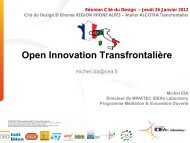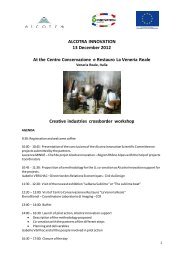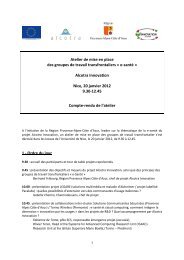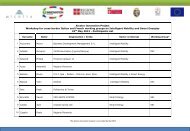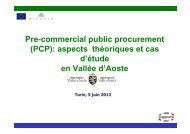Best practices Database for Living Labs - ALCOTRA - Innovation
Best practices Database for Living Labs - ALCOTRA - Innovation
Best practices Database for Living Labs - ALCOTRA - Innovation
Create successful ePaper yourself
Turn your PDF publications into a flip-book with our unique Google optimized e-Paper software.
12. Extension of existing database<br />
As the <strong>Living</strong> Lab movement and the <strong>Living</strong> <strong>Labs</strong> in it are maturing there is an increased need to replicate<br />
the success of some of the <strong>Living</strong> <strong>Labs</strong> in different parts in Europe. Thus the need <strong>for</strong> the definition of real<br />
best <strong>practices</strong> started to grow especially towards the end of the CO-L<strong>Labs</strong> project (ca. 1 year ago). In order<br />
to allow <strong>for</strong> the identification of <strong>Best</strong> <strong>practices</strong> in Europe an Indicator Framework had to be defined.<br />
However the topic of <strong>Living</strong> <strong>Labs</strong> is quite diverse and it is difficult to find Indicators that can be deployed as<br />
best practice indicators regardless of e.g. the thematic issues dealt with inside a <strong>Living</strong> Lab. At the same<br />
time one of the biggest problems in the <strong>Living</strong> Lab area is still that no description of a methodology or<br />
method exists which will helps to deploy a <strong>Living</strong> Lab from scratch, currently the <strong>Living</strong> Lab activities are<br />
mainly steered by case studies with limited transferability. In order to deal with this problem the <strong>Living</strong> Lab<br />
cube was developed by the partners in the CO-L<strong>Labs</strong> project, which identifies the different dimensions of a<br />
living lab and describes how to deploy them.<br />
13. <strong>Best</strong> <strong>practices</strong> criteria<br />
As part of the Corelabs project a framework was developed to assess the per<strong>for</strong>mance of <strong>Living</strong> <strong>Labs</strong><br />
according to the relevant dimensions and characteristics of living labs. Seven categories <strong>for</strong> analysis and<br />
evaluation of the <strong>Living</strong> <strong>Labs</strong> were identified. These categories are derived from the “interoperability cube”<br />
developed within the CORELABS CA (EP# 035065) .<br />
“The harmonization cube not only represents the most important elements of a <strong>Living</strong> Lab, but also enables<br />
specifying bridges between existing <strong>Living</strong> <strong>Labs</strong>, i.e., to learn from each other, benchmark the validation of<br />
user behavior studies, exchange best <strong>practices</strong>, and interconnect the <strong>Living</strong> <strong>Labs</strong>. Next to facilitating a<br />
common ground <strong>for</strong> sharing, the cube model enables recognizing the degree of harmonization of used<br />
methods and tools in <strong>Living</strong> <strong>Labs</strong>.” [4]<br />
Later on an additional indicator was added to identify the contribution of living labs to SME-<strong>Innovation</strong>.<br />
The categories are described below.<br />
Figure 27: Seven Categories<br />
The project is co-funded by the ERDF<br />
Page 67 of 78



